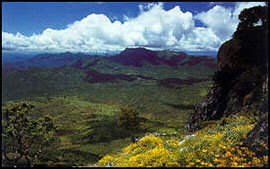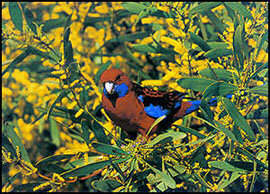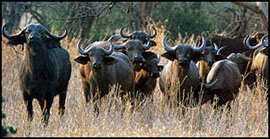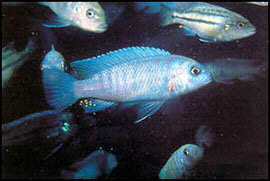 DISCOVERING EDEN DISCOVERING EDEN |
Tourism
Magic of Malawi
Malawi, Lake of Stars
A spider web bright with dew, sunlight spinning on an ivory tusk, elusive dappled stripes, the haunting cry of the fish eagle – moments primeval and unspoilt.
You will penetrate another time scale in the sometimes remote, but always unspoilt national parks of Malawi. Climatic variation and geographical conditions have blessed this corner of Africa with a rich diversity of wildlife, and a conservation conscious government has ensured its preservation for posterity.
Whichever of the five parks you choose to visit (and you may well want to sample them all!) will depend on the time you have available. There are also a number of smaller conservation areas and game reserves which are also worth a visit.
 THE REMOTE NYIKA THE REMOTE NYIKA |

Time is of the essence if you want to experience to the full the wildness and beauty of the Nyika National Park. The approach road to the park is in itself unforgettable, climbing the escarpments to the 2000m high plateau, and affording panoramic views across the northern stretch of Lake Malawi on the way.
Four major rivers have their source high on this plateau, and descending the rugged escarpment, tumble down in spectacular waterfalls. The rolling hills of the plateau area are clothed in waving glass land, criss-crossed by small by small streams, and dotted with copses of rain forest growing in the folds of the hills. Beyond the high plateau is a broken landscape of inaccessible rugged escarpment, steep – sided valleys and isolated massifs.
Remote wild and beautiful, this park is the home of large herds of roan antelope, eland and reedbuck. During the rainy month, from November to May, they can be found grazing on the open grassland of the high plateau, unconcerned and undisturbed. Later in the year they descend to the woodlands for protection from the cold.

Zebra can be seen in vast numbers, alert and ever curious of visitors. Their crazy stripes are eminently visible against the lush green backdrop of the hills, duiker, bushbuck and the comic warthog are regularly seen, and the less common red forest duiker can, with luck, be spotted in the forest patches.
As night falls over the plateau, keep a watchful eye open for the twitch of an ear, a swift movement in the bush. It could be a hyena slinking past, a civet or jackal after prey, a honey badger or porcupine.
Leopards, skilled at camouflage, will only be spotted by an alert eye. You can drive round the park’s roads in the seclusion of your car, or you can take to your feet and become one with the grandeur. Walking is safe and brings Africa close. This is the best way, too, to enjoy the prolific bird life, particularly during November and December when migration brings more brilliant species to sojourn here.
And on foot one can go in search of the exotic orchids, growing here in abundance. Many species have yet to be catalogued. The flamboyant Disa, the showy Satyrium, and many other genera grow here in glorious profusion, as do wild gladioli and iris. In season the slopes are carpeted by brilliant helichrysum and alpine flowers.
Trout are plentiful in the clear mountain streams, and the three dams are well stocked, so opportunities for anglers are exciting. The angling season extends from September to May, and your own rod and tackle must be provided. Permits are available at the park office.
A series of wilderness trails, of one to five days’ duration, allow visitors to explore the most beautiful and remote areas of the park, and on these trees camping out at night enables the wilderness – starved town dweller to recapture inner peace and harmony. Camping is not allowed other than on organised trails.
For those not inclined to the camping life, CHILINDA CAMP is set in a pine forest overlooking on of the dams, and offers comfortable accommodation in double-bedded chalets, with bathroom and kitchen. Visitors must bring their own provision but otherwise the chalets are fully are fully equipped and a servant is available. |  CENTRALLY SITUATED KASUNGU CENTRALLY SITUATED KASUNGU |
KASUNGU NATIONAL PARK lies within easy driving distance from Lilongwe, and offering as it does a large variety of game viewing, is one of the first choices of visitors.
Picturesque LIFUPA WILDLIFE LODGE commands a magnificent view over the Lifupa Dam, the watering hole of a multitude of animals .
The park is natural habitat for elephant – hot rolling woodland areas broken up by dambos, grassy river channels, with occasional rocky outcrop towering through the trees.
There are several herds of buffalo in the park. Among the smaller mammals there are many species of antelope – the magnificent sable, roan and waterbuck, Lichtenstein’s hartebeest, kudu and reedbuck. Scan the bushes and surroundings for lion or leopard, cheetah and wild dog. The powerful spurt of a cheetah after its prey is ample reward for a patient wait.
Early in the morning or as the heat of the day subsides are ideal times to sit in wait at the dam. The resident herd of hippo will provide continuity entertainment, while you wait for the soft-footed elephant, the lively zebra, the graceful buck, or that clown of the wild, the warthog, tail held high as it escorts its offspring away from danger.

There is a network of good untarred roads, many constructed to afford good viewing along the various dambos. Park your vehicle and lie in wait for arrival of elephants as they leave the seclusion of the dense woods, whole families in tow, to drink and cool off in the water. Marvel at the silence of these great beasts, their sudden and dramatic appearance out of nowhere. Drive round the bend to come face-to-face with a lumbering buffalo.
Throughout Malawi bird life is prolific, and here in Kasungu some 200 species have been recorded. Enjoy spotting some of these on a 10km walking trail, which also takes in on its route such interesting features as an old iron-smelting kiln, and geometric rock paintings.
LIFUPA WILDLIFE LODGE offers all facilities fro your comfort. Accommodation is in a 40 bed luxury lodge, including four suites, all overlooking LIFUPA DAM. There are also 16 en suite rondavels and a self- catering tented camp.
 THE UNDERWATER PARK THE UNDERWATER PARK |

LAKE MALAWI NATIONAL PARK is the first park in the world to give protection to the marine life of a tropical, deep water, rift valley lake, and contains an amazing diversity of Mbuna, the dazzling tropical freshwater fish. The park lies at the southern part of the Lake, encompassing the NANKUMBA PENINSULA – the promontory that splits this part of the lake into two arms – and also various of the offshore islands. The scenery is spectacular, sheer rocky outcrops rising from deep wares and clad with tropical growth, mountains, sandy beaches and coves, densely wooded islands, sand dunes and reed marshes.
The crystal clear waters challenge the aquatic minded to don masks and fins and to marvel at the underwater pageant. Tiny gems spotted, striped, translucent, of vivid iridescent hues – these fish dart among the rocks. More than our hundred species have been identified, most of which are unique to these waters.And, attracted by the richness of the underwater harvest, kingfishers – malachite, pied, giant – hover watchfully, cormorants dive in pursuits, fish eagle wait to swoop down on the larger prey – perch, bream carp.Greenbacked herons, goliath and purple herons, wait in endless vigil, and bateleur and black eagles swoop overhead.
Vervet monkey swing and dive from branch to branch, and kilhpspringer and bushbuck inhabit the rock outcrop of the mainland. In the reed marshes, hippopotami and crocodiles, hold sway undisturbed, accompanied by jacanas, ibises and egrets.
An un tarred road runs north, through spectacular tropical scenery, to CAPE MACLEAR, at the head of the NANKUMBA PENINSULA. It’s an easy drive of some 30km from the resorts of CLUB MAKOKOLA and NKOPOLA LODGE and is one of the most beautiful coves on the Lakeshore.
All along this shoreline a luxuriant variety of plants and trees can be seen – the borasus palm, wild fig, baobab, ten metre – high euphorbias and spectacular aloes. |

